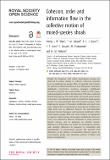Files in this item
Cohesion, order and information flow in the collective motion of mixed-species shoals
Item metadata
| dc.contributor.author | Ward, Ashley | |
| dc.contributor.author | Schaerf, Timothy | |
| dc.contributor.author | Burns, Alicia | |
| dc.contributor.author | Lizier, Joseph | |
| dc.contributor.author | Crosato, Emanuele | |
| dc.contributor.author | Prokopenko, Mikhail | |
| dc.contributor.author | Webster, Michael M. | |
| dc.date.accessioned | 2018-12-14T11:30:06Z | |
| dc.date.available | 2018-12-14T11:30:06Z | |
| dc.date.issued | 2018-12-12 | |
| dc.identifier | 256579452 | |
| dc.identifier | d5dab39c-cf98-4986-8407-3ecea763a40d | |
| dc.identifier | 85059664207 | |
| dc.identifier | 000456566500021 | |
| dc.identifier.citation | Ward , A , Schaerf , T , Burns , A , Lizier , J , Crosato , E , Prokopenko , M & Webster , M M 2018 , ' Cohesion, order and information flow in the collective motion of mixed-species shoals ' , Royal Society Open Science , vol. 5 , no. 12 , 181132 . https://doi.org/10.1098/rsos.181132 | en |
| dc.identifier.issn | 2054-5703 | |
| dc.identifier.other | ORCID: /0000-0001-9597-6871/work/60427813 | |
| dc.identifier.uri | https://hdl.handle.net/10023/16689 | |
| dc.description | Financial support came from the Australian Research Council (grant nos. DP 160103905 and DE 160100630). | en |
| dc.description.abstract | Despite the frequency with which mixed-species groups are observed in nature, studies of collective behaviour typically focus on single-species groups. Here, we quantify and compare the patterns of interactions between three fish species, threespine sticklebacks (Gasterosteus aculeatus), ninespine sticklebacks (Pungitius pungitius) and roach (Rutilus rutilus) in both single- and mixed-species shoals in the laboratory. Pilot data confirmed that the three species form both single- and mixed-species shoals in the wild. In our laboratory study, we found that single-species groups were more polarized than mixed-species groups, while single-species groups of threespine sticklebacks and roach were more cohesive than mixed shoals of these species. Furthermore, while there was no difference between the inter-individual distances between threespine and ninespine sticklebacks within mixed-species groups, there was some evidence of segregation by species in mixed groups of threespine sticklebacks and roach. There were differences between treatments in mean pairwise transfer entropy, and in particular we identify species-differences in information use within the mixed-species groups, and, similarly, differences in responses to conspecifics and heterospecifics in mixed-species groups. We speculate that differences in the patterns of interactions between species in mixed-species groups may determine patterns of fission and fusion in such groups. | |
| dc.format.extent | 14 | |
| dc.format.extent | 1251799 | |
| dc.language.iso | eng | |
| dc.relation.ispartof | Royal Society Open Science | en |
| dc.subject | Shoaling | en |
| dc.subject | Collective behaviour | en |
| dc.subject | Aggregation | en |
| dc.subject | Mixed-species group | en |
| dc.subject | Schooling | en |
| dc.subject | Transfer entropy | en |
| dc.subject | QH301 Biology | en |
| dc.subject | DAS | en |
| dc.subject | BDC | en |
| dc.subject.lcc | QH301 | en |
| dc.title | Cohesion, order and information flow in the collective motion of mixed-species shoals | en |
| dc.type | Journal article | en |
| dc.contributor.institution | University of St Andrews. Centre for Biological Diversity | en |
| dc.contributor.institution | University of St Andrews. Centre for Social Learning & Cognitive Evolution | en |
| dc.contributor.institution | University of St Andrews. School of Biology | en |
| dc.identifier.doi | 10.1098/rsos.181132 | |
| dc.description.status | Peer reviewed | en |
This item appears in the following Collection(s)
Items in the St Andrews Research Repository are protected by copyright, with all rights reserved, unless otherwise indicated.

